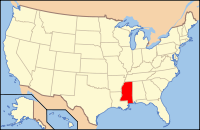Webster County, MS
| Webster County, Mississippi | |
|---|---|
 Location in the U.S. state of Mississippi |
|
 Mississippi's location in the U.S. |
|
| Founded | 1874 |
| Named for | Daniel Webster |
| Seat | Walthall |
| Largest city | Eupora |
| Area | |
| • Total | 423 sq mi (1,096 km2) |
| • Land | 421 sq mi (1,090 km2) |
| • Water | 2.3 sq mi (6 km2), 0.5% |
| Population | |
| • (2010) | 10,253 |
| • Density | 24/sq mi (9/km²) |
| Congressional district | 1st |
| Time zone | Central: UTC-6/-5 |
Webster County is a county located in the U.S. state of Mississippi. As of the 2010 census, the population was 10,253. Its county seat is Walthall. The county is named after statesman Daniel Webster.
Old Greensboro was known for the old Webster County Seat and is still known for the Old Greensboro Cemetery. In 1872 the county seat was moved from Greensboro to LaGrange. In 1874 Sumner County was formed and Greensboro again became a county seat, but this only lasted until 1876 when it was moved to Walthall. Greensboro, which had already begun to deteriorate, rapidly declined. Today the only sign left of its existence is the old Greensboro cemetery. Greensboro was originally the county seat of Choctaw County. Choctaw County was formed from territory acquired in the Treaty of Dancing Rabbit Creek in 1833. At that time it was a much larger county taking in what is now all of Webster County, and the eastern part of Montgomery County and a small portion of Grenada County.
The town of Greensboro, which was centrally located and Choctaw County was inhabited by settlers primarily from Alabama, Georgia and South Carolina. The temporary courthouse and log jail were replaced in 1839 by a brick courthouse and jail. This courthouse was destroyed by fire in 1865 supposedly by an arsonist. Almost all of the early records were destroyed in the fire.
Greensboro at one time consisted of several types of stores and shops, saloons, a livery stable, a brick yard, and a newspaper. Greensboro had a Methodist church as early as 1839 and a Baptist church was begun in 1846. The Greensboro Lodge No. 49 of Free and Accepted Masons was chartered in 1842.
Greensboro had the reputation of a rough and lawless town, many notorious criminals and murders were located there. John A. Murell, a famed outlaw of the Natchez trace was tried and convicted of horse stealing but on being transported to Columbus MS for incarceration he killed his guard and escaped. The Edwards-Gray feud, which grew out of the settlement of the estate of Edward Dewitt Edwards Jr., exploded in 1861. Three of the brothers (William, James, and Robert) of Mrs. Mary "Molly" Gray Edwards, widow of the deceased, shot and killed judge Edward D. Edwards Sr. and his son Luther Edwards. The Gray brothers were jailed, however a mob stormed the jail shooting two and hanging the third.
Two brothers W.F. Brantley and Arnold Brantley were both killed in the vicinity. Arnold Brantley was killed in Winona in 1880. his murderers escaped. Gen. W.f. Brantley was ambushed riding from Winona to Greensboro, by a group believed to have been the killers of an older Brantley brother in Texas. Political candidates frequently campaigned at Greensboro, including, in 1851 Jefferson Davis who was seeking the office of governor. Seven young men of Greensboro and Choctaw County rushed to enlist at the outbreak of the American Civil War. The first company organized was the Wig Fall Rifles, company D 15th MS infantry C.S.A. This unit was formed in Greensboro in April 1861 and the Captain was William F. Brantley of Greensboro later to be one of the youngest confederate generals. In December 1864 federals raided the town and burned much of it.[1] is an external link.
...
Wikipedia
